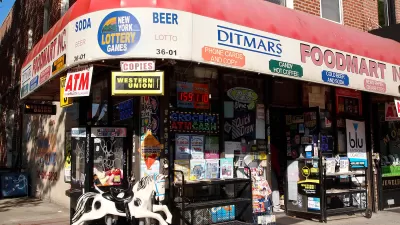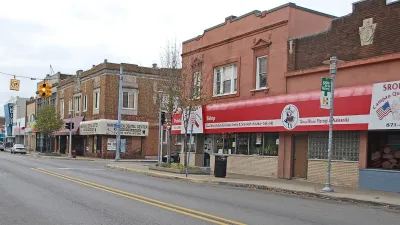Sarah Goodyear looks at how smart phones and augmented reality applications may hold the key to enriching urban exploration and getting Americans off their sofas and out exploring their environments.
According to Goodyear, in 21st-century America, walking "has become an endangered form of locomotion." Saving it from extinction was the topic of a symposium called "Walking and the Life of the City" held last week by the NYU Rudin Center for Transportation Policy and Management.
Delivering the keynote address at the symposium was journalist Tom Vanderbilt, whose recent four-part series of articles in Slate tackled the crisis in American walking. In his address, Vanderbilt noted the sad fact that "people in the U.S. walk less than the citizens of any other industrialized nation."
Other presenters at the symposium looked at the potential for new technologies to facilitate a return to walking. Augmented Reality (AR), like Google's Project Glass wearable computer, was seen as one potential avenue for enriching urban exploration.
Sarah Kaufman, a research associate at the Rudin Center, "expects that in the not-too-distant future, information, navigation, social networking, and advertising related to our surrounding physical environment could all be integrated on devices that we carry with us or wear."
While AR expansion may be a few years off, another presenter addressed the changes that smart phones may already be having on how we view our surroundings, especially those unfamiliar to us.
"Andrew Mondschein, another Rudin Center fellow, presented research suggesting that people who have cell phones make social trips further afield than those who don't. While the findings are preliminary, Mondschein is researching the possible link between the availability of information -- not just on phones, but also online -- and a potential expansion of the city-dweller's horizons," notes Goodyear.
Thanks to Alesia Hsiao
FULL STORY: Can Our Smart Phones Convince Us to Walk More?

Alabama: Trump Terminates Settlements for Black Communities Harmed By Raw Sewage
Trump deemed the landmark civil rights agreement “illegal DEI and environmental justice policy.”

Planetizen Federal Action Tracker
A weekly monitor of how Trump’s orders and actions are impacting planners and planning in America.

The 120 Year Old Tiny Home Villages That Sheltered San Francisco’s Earthquake Refugees
More than a century ago, San Francisco mobilized to house thousands of residents displaced by the 1906 earthquake. Could their strategy offer a model for the present?

Ken Jennings Launches Transit Web Series
The Jeopardy champ wants you to ride public transit.

BLM To Rescind Public Lands Rule
The change will downgrade conservation, once again putting federal land at risk for mining and other extractive uses.

Indy Neighborhood Group Builds Temporary Multi-Use Path
Community members, aided in part by funding from the city, repurposed a vehicle lane to create a protected bike and pedestrian path for the summer season.
Urban Design for Planners 1: Software Tools
This six-course series explores essential urban design concepts using open source software and equips planners with the tools they need to participate fully in the urban design process.
Planning for Universal Design
Learn the tools for implementing Universal Design in planning regulations.
Clanton & Associates, Inc.
Jessamine County Fiscal Court
Institute for Housing and Urban Development Studies (IHS)
City of Grandview
Harvard GSD Executive Education
Toledo-Lucas County Plan Commissions
Salt Lake City
NYU Wagner Graduate School of Public Service





























